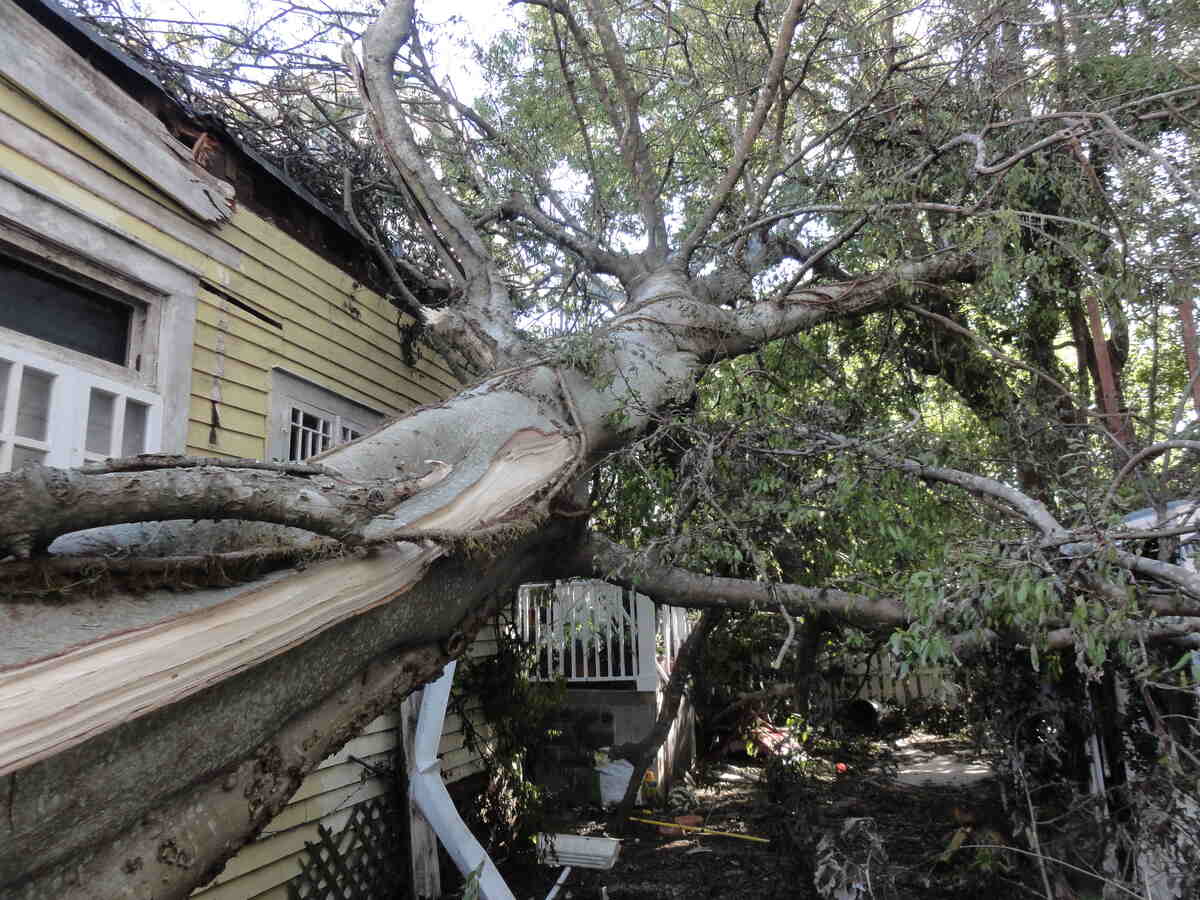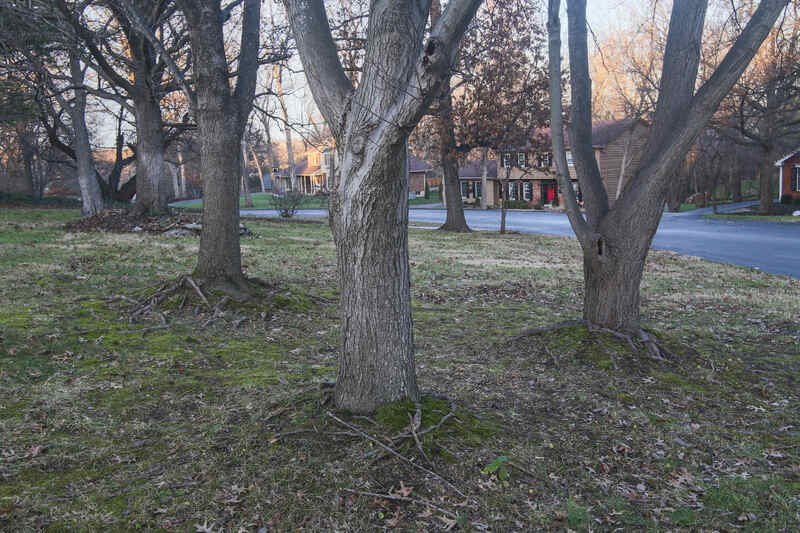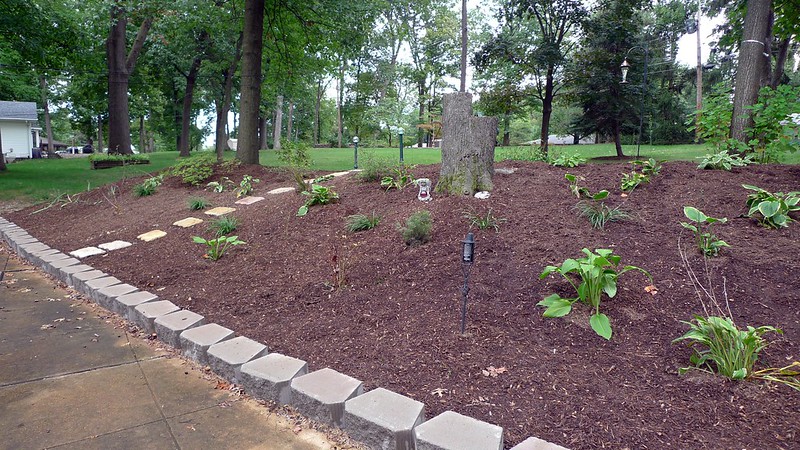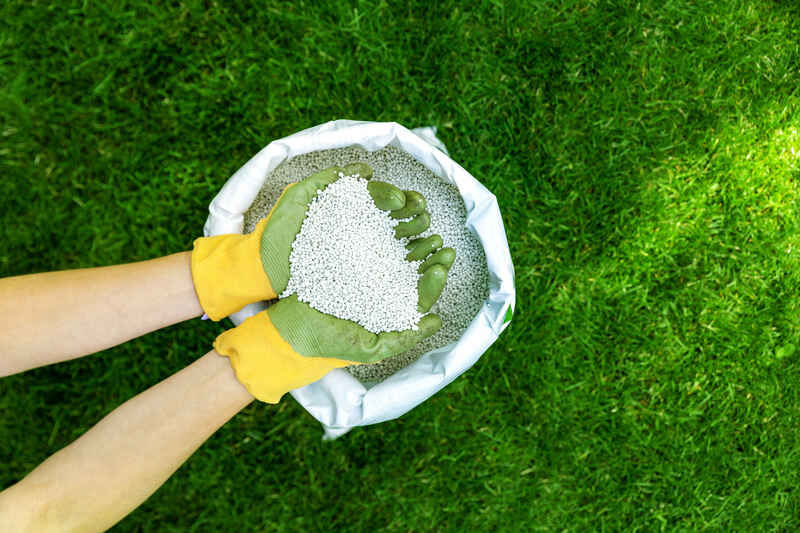
St. Lucie County homeowners are no strangers to hurricanes. This high-risk hurricane zone has had over 80 recorded hurricanes since 1930. Whether you’re the most experienced hurricane prepper or a complete newbie to the area, these 11 hurricane-resistant landscaping ideas for Port St. Lucie (PSL) will help you plan, execute, and safeguard your landscape.
Here are 11 ideas to fortify your PSL landscape against hurricane damage:
- 1. Inspect Your Trees
- 2. Use Wind-Resistant Trees
- 3. Group Trees
- 4. Right Tree/Right Spot
- 5. Choose Salt-Resistant Plants
- 6. Select Hurricane-Resistant Fencing
- 7. Build a Sea Wall
- 8. Get Rid of Rocks (Use Mulch Instead)
- 9. Water Properly for Strong Roots
- 10. Skip the Fertilizer
- 11. Remove Sprinkler System Risers
- Evacuate (When All Else Fails)
- FAQ About Hurricane-Resistant Landscaping
1. Inspect Your Trees
The impact of hurricanes can devastate your trees:
- The powerful winds associated with these storms can easily uproot trees, leaving them with broken branches and snapped trunks.
- Flooding can cause tree roots to choke on standing water. Their stress levels then rise and weaken them, making them more susceptible to diseases.
So, how do you know if your trees are in good condition? Give your trees a checkup. You can hire an arborist to do this or give them a once-over yourself. Here are a few things to look for:
- Broken, damaged branches or dead branches
- Yellowing leaves
- Brown and dying leaves and needles
- Spots or blemishes on bark, leaves, and/or fruit
- Fuzzy or moldy-looking patches
- Holes in the leaves
- A leaning tree
Pro Tip: If you’re concerned about the health and well-being of your trees, it’s important to seek the advice of a professional. Hiring a certified arborist can provide the expertise you need to ensure your trees are in good condition.
With their extensive knowledge of tree health and potential issues, an arborist can diagnose problems and provide the necessary landscaping services to keep your trees thriving.
Additionally, an arborist can ensure that trees are properly pruned and cared for using the principles of “tree biomechanics.”
2. Use Wind-Resistant Trees

Choosing the right trees for your property is crucial, especially if you live in an area prone to hurricanes. To ensure your trees can withstand these conditions, look for deep roots and a low center of gravity.
The UF (University of Florida) IFAS scientists have identified types of trees resistant to wind damage:
- Southern Magnolia (Magnolia grandiflora)
- Sand Live Oak (Quercus geminata)
- Crape Myrtle (Lagerstroemia indica)
- Bald Cypress (Taxodium distichum)
- Sabal Palm (Sabal palmetto)
- Mexican Fan Palm (Washingtonia robusta)
IFAS scientists warn against using these trees that are less wind-tolerant:
- Laurel Oak (Quercus laurifolia)
- Sand Pine (Pinus clausa)
- Chinese Elm (Ulmus parvifolia)
- Water Oak (Quercus nigra)
3. Group Trees

Did you know planting trees in groups can help protect them during a hurricane? This is because when trees are planted together, they provide mutual protection by reducing wind velocity.
Planting trees in groups instead of lines can be beneficial in reducing storm damage overall. So, if you’re replanting after a hurricane or other natural disaster, it’s recommended to create groups of at least five trees planted together to give them the best chance of survival.
4. Right Tree/Right Spot
During a hurricane or severe storm, trees and large shrubs can pose a serious threat to overhead power lines, potentially causing power outages and flickering. To mitigate this risk, it is crucial to carefully choose the right type of tree for the area in question.
Have existing trees and shrubs pruned and maintained regularly. If the arborist doesn’t do the physical work of tree pruning, they may recommend a tree service to prune limbs around your house and power lines. A hurricane is terrifying enough, nobody wants the additional headache of a huge, dead tree crashing through their roof to add to the situation!
Consider smaller ornamental trees if you want to add trees and the power lines are overhead. Research their height and habit (how they grow and what they look like) or get a landscape designer to develop a landscape plan to add the additional trees. This will alleviate your worries and add structure and color to your property without sacrificing safety.
Of the wind-resistant trees listed above, these are the shortest two:
- Crape Myrtle: 10-30 feet tall
- Sabal Palm: Up to 40 feet tall
5. Choose Salt-Resistant Plants
Salt-resistant plants are becoming increasingly important in areas prone to hurricanes and storm surges. In 2022, Hurricane Ian devastated the Treasure Coast with its powerful winds, but the aftermath caused further damage. The high concentration of salt left behind by the storm surge saturated plants, leading to widespread die-offs of palm trees and other vegetation.
Salt-resistant plants are crucial in these areas to ensure the survival of local flora and fauna. Looking for some suggestions for plant material that can take a salt beating? The list below will give you a small sampling of salt-tolerant plant material for your yard:
- Oleander (Nerium oleander)
- Salt Spray Rose (Rosa rugosa)
- Wax Myrtle (Myrica cerifera)
- Fountain Grass (Pennisetum setaceum)
- Daylily (Hemerocallis spp.)
- Beach Sunflower (Helianthus debilis)
6. Select Hurricane-Resistant Fencing

Many people believe a solid privacy fence is the best option for protecting their property during a hurricane. However, this is a common misconception.
Why solid fences don’t work: A solid fence is more likely to be damaged by high winds than a slatted or chain link fence. This is because the wind can push against the solid surface, causing it to topple over or even be pulled out of the ground.
Why “open” fences are a better option: A fence with openings allows the wind to pass through, reducing the risk of damage.
Best hurricane-resistant fencing options: An open metal fence, like a chain link fence, would be a good option, as metal tends to be more durable. Black chain-link fencing blends with your landscaping, keeping kids and pets safe, and is budget-friendly.
7. Build a Sea Wall
When living in an area prone to hurricanes, protect your property from the damaging effects of flood waters and crashing waves. One option is to build a sea wall. These walls can help buffer the impact of waves, reduce erosion, and shore up your property.
The material you choose will be a big factor in your sea wall’s cost, appearance, and functionality. Here are several of the most commonly used seawall materials to consider.
- Concrete is known for withstanding the elements and time and is used with the expectation to last 20 to 30 years without needing any attention. Concrete seawalls built in the 1970s and before are still strong.
- Wood is commonly used on freshwater properties that do not require the strength or corrosive resistance of concrete.
- Steel is primarily used when the exposed wall height is very large. Using a long-lasting interlocking system can create a strong, continuous wall.
- Composite materials are reinforced fiber polymer profiles that when combined make an extraordinary strong seawall. Composites are an alternative to concrete, steel, or vinyl and are available in a variety of colors.
- Vinyl works for small projects, but if you have a large project, vinyl can’t often stand up to concrete in strength and durability.
Other factors, such as location, zoning, and marine influence (what type of body of water you’re near) will also affect the best type of sea wall to build. Sea wall construction is best left to the experts. Hire an experienced contractor to take into account all of these factors and build a functional, beautiful wall for your PSL landscape.
8. Get Rid of Rocks (Use Mulch Instead)

River rock, pea gravel, and red tipple stone can add beautiful texture and color to your pathways, gardens, and garden edging. But they can cause considerable damage during a hurricane or tropical storm, shattering house and car windows and denting house siding. Using soft materials for pathways and garden beds reduces the damage during a hurricane.
What to use in place of rocks: Choosing soft materials can help minimize the damage caused by hurricanes. Instead of using hard materials like pebbles and stones, opt for wood chips, triple-ground or double-ground mulch, or shredded bark.
How Much is Mulch?
On average, mulch costs from $17 to $68 per cubic yard, while a bag of mulch typically costs between $2 and $5.50. If you’d like to use mulch, you can spread it yourself as an easy DIY project or have a local landscape company do it for you.
If you’re looking to have your mulch professionally installed, you can expect to pay an additional fee of $20 to $45 per cubic yard or an hourly rate of $43 to $98, depending on the pricing structure of your landscaper.
9. Water Properly for Strong Roots
Establish strong roots through proper watering techniques during normal weather conditions or dry spells. Whatever you do, don’t waterlog your grass and trees during the year. Overwatering causes root systems to rot and weaken (not ideal during a hurricane!). Instead, here’s how to properly water your lawn and trees:
- How to water your grass: In Florida’s sandy soils, it’s best to water 1/2 inch at a time, as often as two to three times per week if there’s no rain. Water before 8 a.m. and pay attention to the current lawn watering restrictions and your grass type.
- How to water your trees: Watering trees can be complex. It depends on the age of the tree, your soil, and the tree species, but a few common rules still apply: Water early in the morning, water young trees more often than established trees, and look for wilted leaves to know if you’ve underwatered.
For more details, check out our article on How Much, How Often, and How Best to Water Your Trees.
10. Skip the Fertilizer

If a hurricane, tropical storm, or heavy rain is in the forecast, don’t fertilize. Not only is it a waste of time and money, but the excess fertilizer can be washed away by the heavy rain and end up in nearby water sources, causing harm to the environment.
11. Remove Sprinkler System Risers
To avoid any harm to the underground piping of your sprinkler system, it is essential to remove the irrigation risers. (Articulated risers, also known as swing arms, enable the sprinkler to move and adjust, allowing quick and easy shifting up or down.)
Removing the risers also reduces the risk of debris entering and clogging the irrigation system. If you get overwhelmed and don’t know how to approach this, call your sprinkler system company to come in and save the day.
Evacuate (When All Else Fails)
When a hurricane is predicted, watch for notifications from your local media outlets. The government will enact mitigation measures to protect people, property, and structures from hurricane winds, flooding, and storm surges. Do not stay in place if your local officials advise otherwise. Evacuation is your best chance for survival.
You can’t control everything, but by being PSL prepped, you’ll know you have done everything to get your property as “hurricane-proofed” as possible.
FAQ About Hurricane-Resistant Landscaping
The Saffir-Simpson Hurricane Wind Scale, developed by the National Weather Service, rates hurricanes based on their sustained wind speed. The scale ranges from 1 to 5, the higher the number, the more severe the storm and the greater potential for property damage.
Understanding the Saffir-Simpson Hurricane Wind Scale can help you know what’s coming. Here are some key points about the kind of damage to expect given the strength of a storm:
● Category 1 hurricane: Damage from very dangerous winds, including damage to roofs, gutters, and siding. Power outages. Large branches and trees with shallow roots can fall.Winds 74-95 mph.
● Category 2 hurricane: Damage from extremely dangerous winds, including major damage to homes (siding and roofs). Trees with shallow roots will be overturned and cause road blockages. Extensive power outages that continue for a few days to several weeks. Winds 96-110 mph.
● Category 3 hurricane: Damage is devastating. Roof decking may be pulled from homes. Trees overturn and cause road blockages. Power and water outages that continue for a few days to several weeks. Winds 111-129 mph.
● Category 4 hurricane: Damage is catastrophic. Roof structures and walls may be pulled down. Most trees are uprooted. Power poles fall and outages last several weeks to a few months; the area will not be habitable for the same length of time. Winds 130-156 mph.
● Category 5 hurricane: Damage is catastrophic. A greater number of homes are destroyed due to failing roofs and walls. Trees and power lines toppled. Outages last several weeks to a few months; the area will not be habitable for the same length of time. Winds 157 mph or higher.
No. Most emergency shelters will not accept pets during a hurricane evacuation. Make evacuation plans well in advance of hurricane season so that if evacuation is required, both you and your furry friend have a welcoming place to stay.
Maintain a Hurricane-Resistant Landscape
When preparing for a hurricane, there’s a lot to do, which can be overwhelming. In addition to securing your property and stocking up on supplies, you may also need help with landscaping tasks like a bit of last-minute pruning or gutter cleaning.
If you’re feeling stressed and need assistance, consider hiring LawnStarter’s professional landscaping service to take care of these tasks. This way, you can focus on other important preparations and have peace of mind knowing your property is in good hands.
Additional source:
Main Image Credit: Michael Homan / Wikimedia Commons / CC BY 2.0